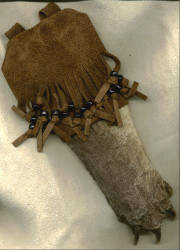|

I case skinned each paw, fleshed them out as well as I could, then dried them with plenty of salt.
I had never tried to tan turtle skin before and aside from a few taxidermy mounts, I had never seen any turtle tanned.
I am not sure if I did a good job of it or not because I have nothing to compare it to. But I tried. And the pouch is interesting
enough. I tanned the paw just like I would any other type of skin. Then I took some scrap leather from an old coat, stitched
a band around the top of the paw, sewed the back of the band shut and put a cover flap on top. There are two hanging loops
in back to go on a belt. I cut the fringe and added beads. I also made a liner out of muslin.
This is a very deep pouch. It would be good for a pipe bag or maybe a strike-a-light kit, but I have difficulty getting
anything small and light weight out of it simply because it is so narrow and deep. It is about 3.5 inches wide across the
top and 11.5 inches overall from the top to the tip of the claws. Each claw is an inch long. It was a big turtle.
As for the turtle leather, it is somewhat stiff. Not rawhide stiff but it certainly is no suede. I will try another sometime
and see if there is anything I can do to soften it up more.
|
 |
|
|
|
 |
|
A Note on Turtles:
Many Native American cultures believe that the world is resting on a giant turtle's back. What we know today as North
America is often referred to as the Turtle Island. When all the world was water, turtle offered to carry the bit of land brought
up from the water's bottom by loon (sometimes by muskrat or others depending on the myth's locality) upon his back so the
other animals would have a place to live. Creator made the land grow large enough for all the people of all the nations. And
there it sits to this day.
Another interesting thing is that there are thirteen large central plates on a turtle's back. One for each of the thirteen
full moons in a lunar year.
|
 |
|
|
|

